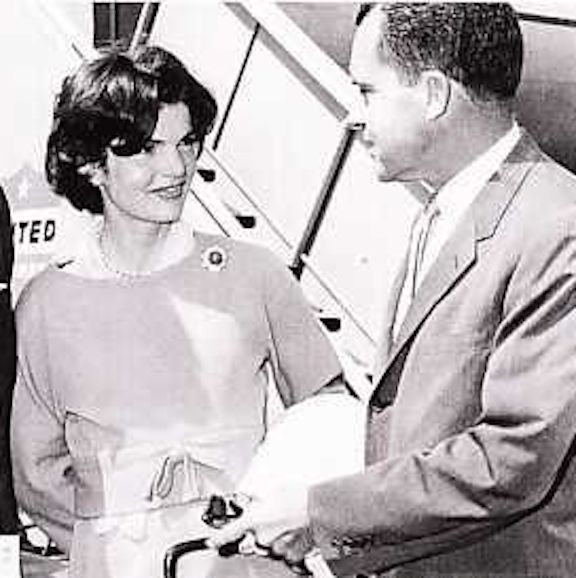
Fifty years ago today, on February 3, 1971, former First Lady and widow of President John F. Kennedy, by then remarried, made her first and only visit back to the White House.
After the trauma of her first husband’s assassination on November 22, 1963, Jacqueline Kennedy Onassis vowed to never return to the executive mansion.
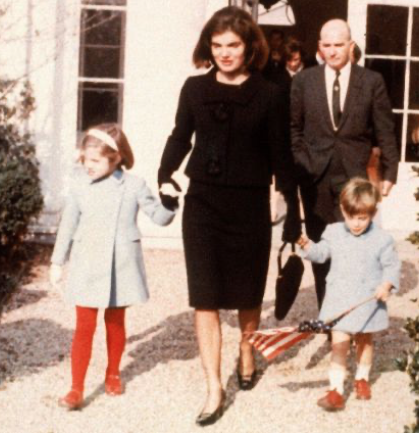
With her strong sense of duty to history, as well as a determination to raise her daughter and son, Caroline and John, as simultaneously “normal” yet heirs to a presidential legacy, she nevertheless broke her vow. Just once.
From a politically partisan perspective, it seemed as if her hosts would have been the least likely to have lured her back. From a human and familiar viewpoint, as well as respect once shown by those who have occupied the presidency, especially by those who had once held the position or been married to one who had, it made perfect sense. And so, in the new year of 1971, President Richard Nixon and his wife, First Lady Pat Nixon, invited Jacqueline Kennedy Onassis for a visit and dinner at the White House. And she accepted.
At the request of the former First Lady, no photographs were taken during the few hours she returned to the White House. Richard and Pat Nixon honored her request. Based on descriptions of the visit, however, and using period images, the author has created several plates of composite photo images to commemorate the event, appearing herein for the only time.
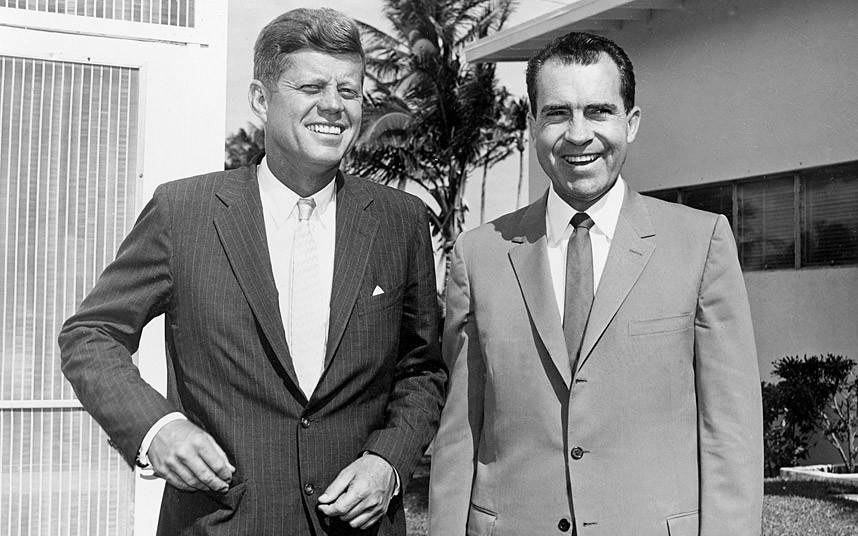
Richard Nixon and John F. Kennedy had both come to Congress at the same time, both elected in 1946. Despite their political, regional, personal and even other differences the two young men got along well; they were even characterized as “friends.” Even more startling was the fact that when Congressman Nixon was running against the Democrat Helen Gahagan Douglas for the U.S. Senate seat from California, Congressman Kennedy himself came down the hall and turned over a check for a thousand dollars from his father, to “be used in Nixon’s campaign for senator…due partly to admiration for Nixon and partly to a preference for Congressman Nixon over Congresswoman Douglas.”
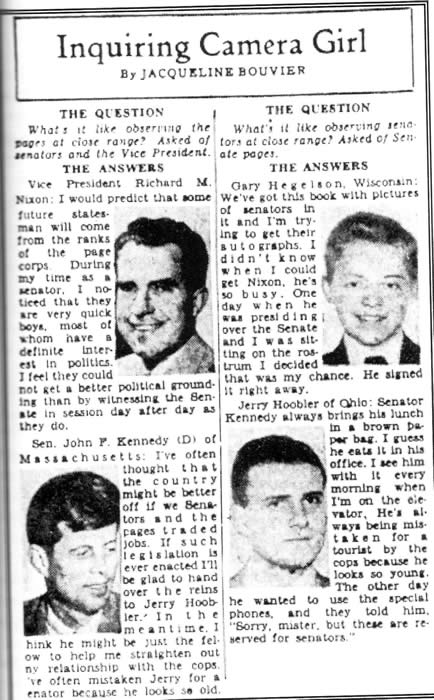
Before she had married U.S. Senator John F. Kennedy, Jacqueline Bouvier first met both Nixons, and their daughters Tricia and Julie, when she interviewed them for her newspaper column, The Inquiring Cameragirl. Following her engagement to Kennedy, Dick and Pat joined Jack and Jackie at a dinner party, followed by the Washington premier of the Broadway musical comedy, Guys and Dolls. The Kennedys invited the Nixons to their wedding, though the then-Vice President and his wife were unable to attend.

Over the next six years, Jackie Kennedy, in her role as the wife of a U.S. Senator would cross paths with Pat Nixon, in her role as wife of the Vice President and as the president of an informal organization known as the Senate Wives. On one occasion, at First Lady Mamie Eisenhower’s annual luncheon for the spouses, future First Lady Lady Bird Johnson, also then a Senate wife, recalled how Pat Nixon “saved the day” for Jackie by introducing her as Mrs. Kennedy, avoiding any reminder of her having been the single newspaper columnist who had once stalked her young nieces for a story. When Senator Kennedy was recovering from back surgery in 1954 and Vice President Nixon wrote him, it was Jackie who replied:
“I don’t think there is anyone in the world he thinks more highly of than he does you–and this is just another proof of how incredible you are.”
When his neighbor Joan Gardner called Nixon “dreadful” at a dinner party hosted by the Kennedys, JFK cracked, “You have no idea what he’s been through. Dick Nixon is the victim of the worst press that ever hit a politician in this country. What they did to him in the Helen Gahagan Douglas race was disgusting.” So fondly did the two couples feel about each other in the 1950s that Senator Kennedy told his friend Charlie Bartlett that if he did not get his party’s nomination in 1960, he would vote for the Republican Nixon.

Kennedy and Nixon did face one another in the presidential election, the media determined to run a parallel “race for First Lady,” juxtaposing Jackie Kennedy and Pat Nixon based on how much they spent on their clothing. Pat Nixon remained silent, but her husband’s campaign reminded the media that she only bought American-made clothes. Jackie Kennedy responded not by admitting that some of her wardrobe was from Paris but pointing out that Mrs. Nixon bought clothes from the expensive Elizabeth Arden salon in Washington. Neither woman took the hyped-up rivalry seriously.
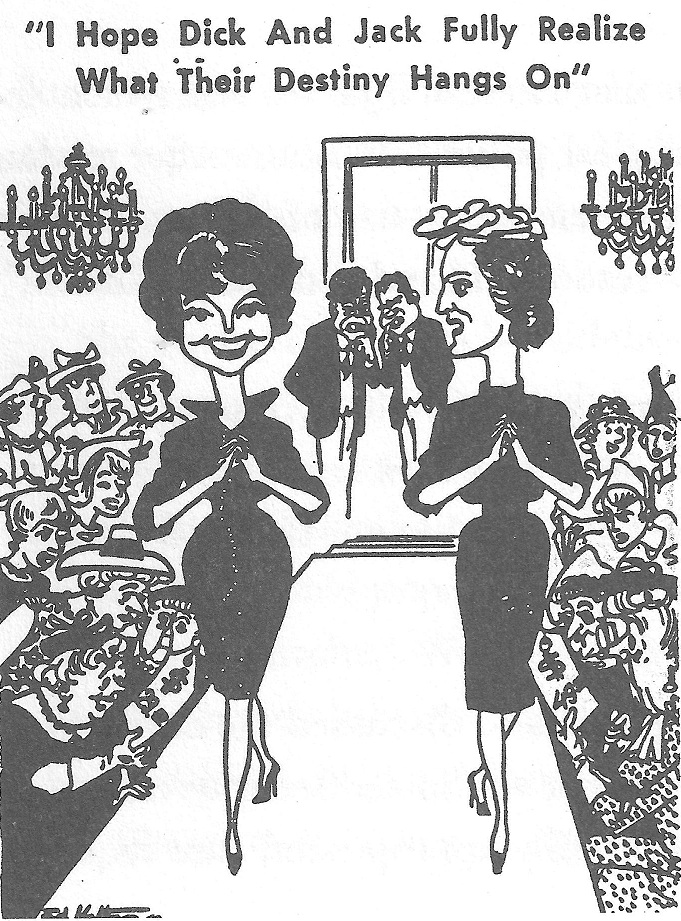
Pat Nixon was among those who became convinced that the 1960 presidential election had been stolen by the Kennedy forces, robbing her husband of a rightful victory. For the sake of the country, Richard Nixon never made reference to the election being rigged, stolen, a hoax or in any way illegal. He did not ask for a recount. Despite the pain of losing in such a close election, he maintained his dignity and thereby that of the presidency and the nation.
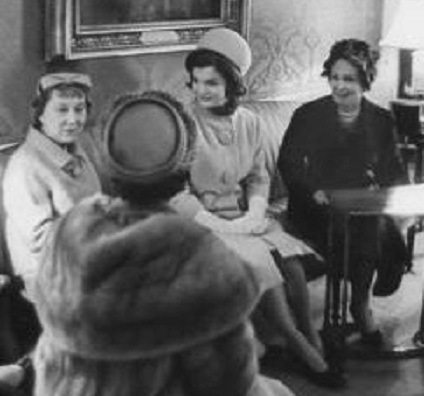
Richard and Pat Nixon attended the Kennedy inaugural. At the traditional morning coffee hosted by the outgoing President and First Lady, Pat Nixon and Jackie Kennedy found themselves seated tightly together on a sofa, alongside Mamie Eisenhower and Lady Bird Johnson.
Despite resenting the fact her husband’s campaign advisers had told her American voters wanted her to get a “Frizzy perm and be like Pat Nixon,” Jackie Kennedy noted that the outgoing Second Lady that day looked “rather New York chic.”
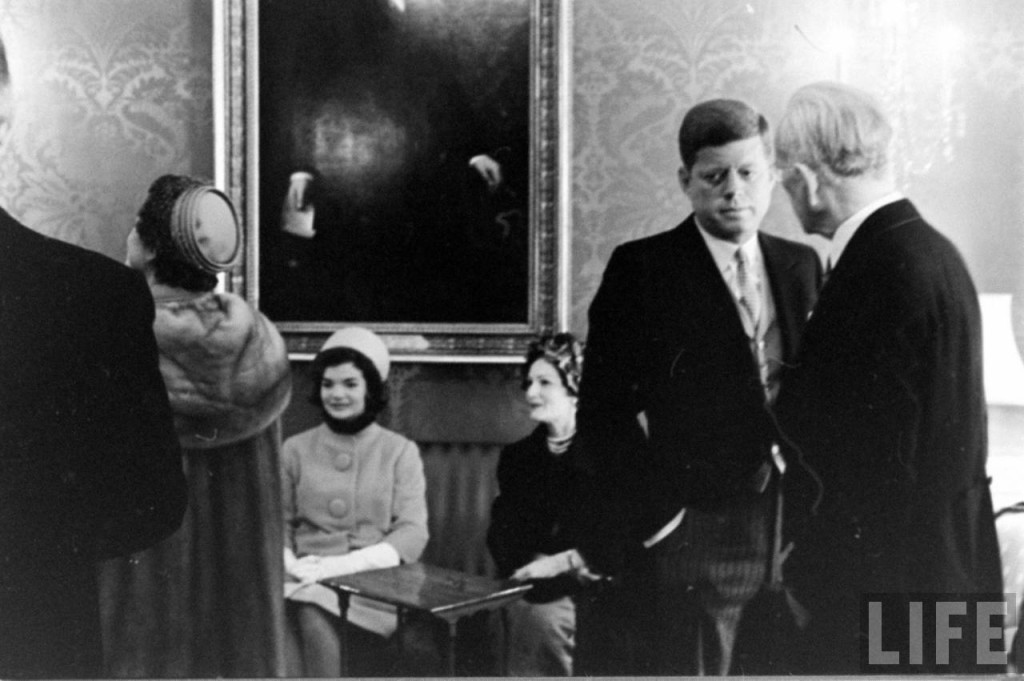
The Nixons did not see the Kennedys during their White House incumbency. Hours after the president’s assassination Nixon wrote Jacqueline Kennedy:
Dear Jackie,
In this tragic hour Pat and I want you to know that our thoughts and prayers are with you.
While the hand of fate made Jack and me political opponents I always cherished the fact that we were personal friends from the time we came to the Congress together in 1947. That friendship evidenced itself in many ways including the invitation we received to attend your wedding.
Nothing I could say now could add to the splendid tributes which have come from throughout the world to him.
But I want you to know that the nation will also be forever grateful for your service as First Lady. You brought to the White House charm, beauty and elegance as the official hostess of America, and the mystique of the young in heart which was uniquely yours made an indelible impression on the American consciousness.
If in the days ahead we could be helpful in any way we shall be honored to be at your command.
Sincerely,
Dick Nixon
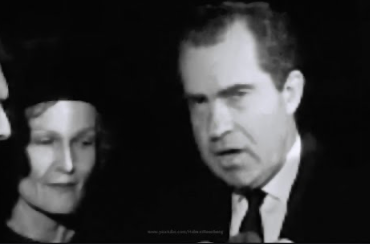
Jackie Kennedy ensured that the Nixons were invited to her late husband’s funeral, and they appeared at St. Matthew’s Catholic Church for the services. Several weeks later, she responded to Nixon’s letter, revealing not only her political instincts and remarkably prophetic foresight:
Dear Mr. Vice President –
I do thank you for your most thoughtful letter –
You two young men – colleagues in Congress – adversaries in 1960 – and now look what has happened – Whoever thought such a hideous thing could happen in this country –
I know how you must feel – so long on the path – so closely missing the greatest prize – and now for you, all the question comes up again – and you must commit all you and your family’s hopes and efforts again – Just one thing I would say to you –if it does not work out as you have hoped for so long – please be consoled by what you already have – your life and your family –
We never value life enough when we have it – and I would not have had Jack live his life any other way – thought I know his death could have been prevented, and I will never cease to torture myself with that –
But if you do not win – please think of all that you have – With my appreciation – and my regards to your family. I hope your daughters love Chapin School as much as I did –
Sincerely
Jacqueline Kennedy
By this time, following his defeat in 1962 for the governorship of California, the Nixons relocated to the East Coast a year later, living in an apartment on Fifth Avenue.
A year later, the widowed Jackie Kennedy and her children, Caroline and John, also moved to New York’s Fifth Avenue, walking distance from the Nixons.
For four years and several months, from 1964 until January 1969, Jackie and the Nixons were neighbors, but there was no known encounters between them either at restaurants, events or even randomly walking around Central Park. They would next see each other in the dark aftermath of two tragic events that had political ramifications for the presidency in the election year of 1968.
Then the leading Republican candidate for the presidency, Richard Nixon attended with Michigan Governor George Romney and his wife Lenore in the Atlanta Baptist Church for the April 1968 funeral of assassinated civil rights leader, Martin Luther King, Jr. Unexpectedly, two women slipped into the pre in front of him. It was the heiress Rachel Mellon and her friend, Jacqueline Kennedy, seated near Senator Teddy Kennedy. Startled, he leaned over to whisper, “Mrs. Kennedy, this must bring back many memories.” She either did not hear him or chose not to respond.
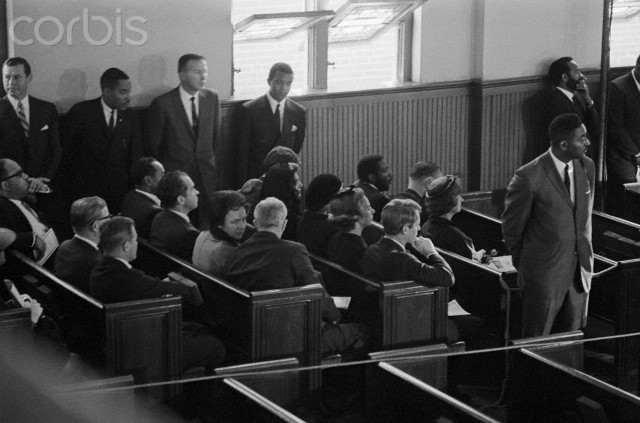
Three months later, Jackie Kennedy saw to it that the Nixons were invited to the St. Patrick’s Cathedral funeral of her brother-in-law, the U.S. Senator from New York and leading Democratic presidential candidate Robert F. Kennedy.

Four months after that, Jacqueline Kennedy and the Nixons were headliners around the world. On October 20, 1968 Jacqueline Kennedy remarried in Greece, to Aristotle Onassis. Two weeks later, Nixon was elected President with Spiro Agnew as Vice President. Comedian Bob Hope saw a connection between the two events: “Nixon got a Greek running mate – and now everybody wants one.”
The new Mrs. Onassis wrote a letter of congratulations to the Nixons.
At the same time, the Committee for the Preservation of the White House, which Mrs. Kennedy had created, recommended replacing a 1951 mantel in the presidential bedroom, on which Jackie had a plaque secured stating that she and President Kennedy had lived in that room. The recommended replacement dated to 1816, removed from a home designed by the second architect of the White House, Benjamin Latrobe. The outgoing First Lady, Lady Bird Johnson approved the replacement but it did not occur until several weeks later, after the new Nixon Administration had begun. The press contorted the fact so that it seemed that, out of some political resentment, the Nixons banished the reminder of the Kennedys. It was untrue. Patricia Nixon.”
Although her own efforts received scant press attention, Pat Nixon continued the White House restoration begun by Jackie Kennedy, building up a far larger collection of historical furnishings of paintings and furniture, using many of the pieces in her refurnishing of the public reception rooms of the state floor. As had Mrs. Johnson, Mrs. Nixon invited her predecessor to the meetings of the preservation committee. And as she had responded to Mrs. Johnson, Mrs. Onassis wrote similarly to Pat Nixon, on January 7, 1970 that “the thought of seeing the White House again will be painful. I have returned to Washington only to visit Arlington [where JFK was buried.]
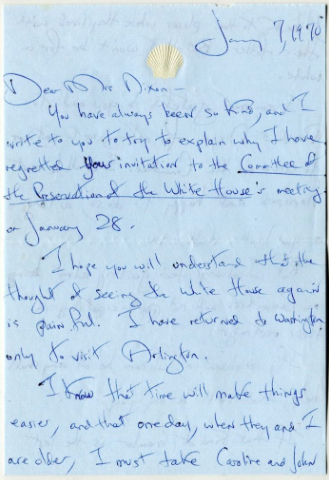


Unlike other former Presidents, John F. Kennedy died before he was able to pose for a White House portrait. By now, it was the White House Historical Association, which she had created, which commissioned the official portraits of Presidents and First Ladies. Jackie posed for hers, by artist Aaron Shikler in 1968, depicted in the living room of her Fifth Avenue apartment. Although she posed in several outfits, the final choice she decided on for herself showed her in a long gown with a scarf and scalloped high-neck, in gold and pink hues, looking to the side. It was an ethereal, romanticized image, with a sense of sadness. Shikler executed his portrait of President Kennedy from photographs. It is unlike any other presidential portrait, his eyes not visible as he looks down, deep in thought.
After approving both canvases, they were sent to the White House where a February 5, 1971 public unveiling was scheduled. Mrs. Nixon invited her to it .Jackie knew she could not trust her emotions at such an event. She wrote to Pat
“As you know, the thought of returning to the White House is difficult for me. I really don’t have the courage to go through an official ceremony and bring the children back to the only home they both knew with their father under such traumatic conditions. With the press and everything, things I try to avoid in their little lives, I know the experience would be hard on them and not leave them with the memories of the White House that I would like them to have.
Nancy Tuckerman, the lifelong confidante and aide to Jackie, flew to Washington to hand deliver the letter to the First Lady, in which she suggested that private unveiling for her children would be possible. Pat asked Nancy to call Jackie, who agreed to come back, with her children, on the condition that there be no press coverage. Or any photographs at all. Only the curator, chief usher and two servers were told. The First Lady’s press secretary’s not even told about the secret return.
After Caroline and John Kennedy had finished school, a car took them with Mrs. Onassis to the airport named for her late husband, where a small military jet had been sent by President Nixon to retrieve them. Once landed in Washington, a White House limousine met them on the tarmac and they were whisked away to their former home, entering the drive onto the South Lawn at 5:30 in the afternoon.
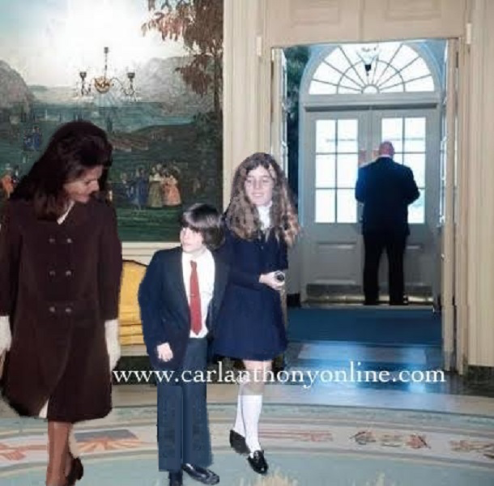
President Nixon recalled that he and his family had greeted the Kennedys in the Diplomatic Reception Room. His daughter Julie Nixon Eisenhower, however, recalled that the Kennedys were brought up the private quarters where she, her mother and sister Tricia met them to guide a tour of the familiar rooms, now with the new First Lady’s own touch to them. Julie thought she looked very much like the thousand of photographs printed of her, though more athletic in physicality. The former First Lady wore a long-sleeved black dress. Her daughter was still in her school uniform and a sweater.
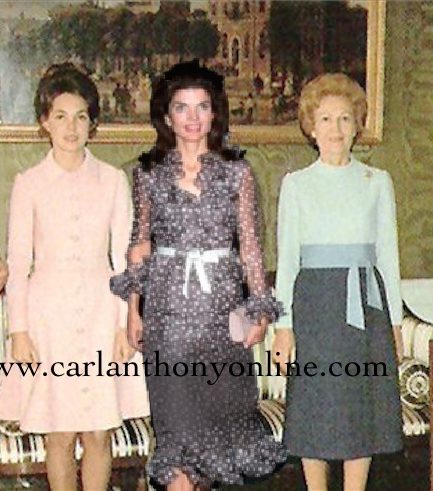
Jackie later told the former Chief Usher, her friend J.B. West that she thought the changes were wonderful and, importantly, necessary. “It must always evolve,” she said.
Then it was time for them to see the Kennedy portraits. The public unveiling two days later would show them on easels in the East Room, but for the family they were seen where they would be placed, his in the Green Room, his favorite place in the White House, and hers on the ground floor, just outside the door of the Diplomatic Reception Room. Pat Nixon stood back to give the trio time to enjoy them alone. The Kennedy children thought their mother’s fingers looked longer than normal in the painting. Mrs. Onassis thanks Mrs. Nixon for placing the late president’s portrait in so prominent a place.
From there, the continued through the house, the children shown their old bedrooms by the Nixon daughters as well as the third floor solarium, which had served as Caroline’s kindergarten. The children enjoyed the night view of the city from atop the White House.
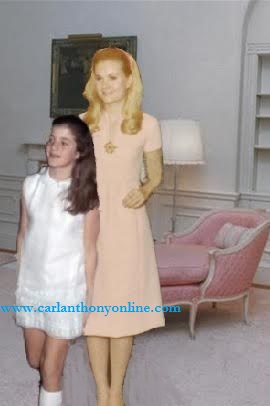
Meanwhile, Pat Nixon showed Jackie Kennedy Onassis the garden flanking the East Wing, which Lady Bird Johnson had named in her honor. They returned to the residence, up to the second floor where they gathered with President Nixon for cocktails in the oval room which, as Mrs. Kennedy, Jackie had designated as yellow. Although Pat Nixon had changed the decor, the same basic furniture and look remained. President Nixon recalled that a White House butler who had been there during the Kennedy years served the former First Lady a glass of white wine, with ice in it. She explained that was how she had drank it while she was First Lady.
Then it was time for dinner.
The President and Mrs. Nixon, Mrs. Onassis, the two Nixon daughters and the two Kennedy children gathered around the antique table in the President’s Dining Room, a room that she had created which permitted presidential families to take their meals within their living quarters on the second floor. The menu consisted of a shrimp appetizer, beef tenderloin, mimosa salad, artichokes and mushrooms, and a citron souffle for dessert.
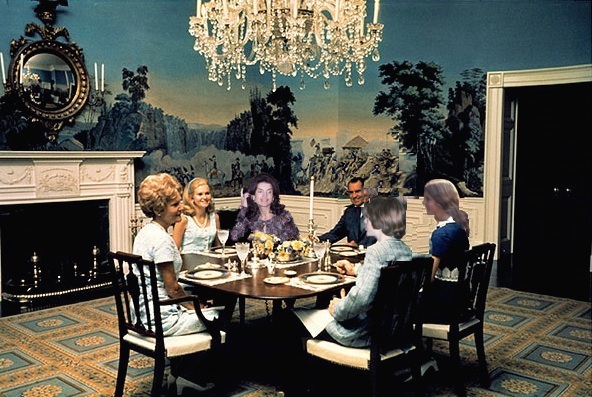
Nixon found Jackie to be “very bright and talkative” at dinner. They talked about a mutual friend, Alice Roosevelt Longworth, daughter of president Theodore Roosevelt. This room had been her bedroom and here she had her appendix removed. Jackie Onassis reminisced only once, referencing her late husband as she recalled that when the rooms were being painted “they practically suffocated.”
The President and former First Lady talked a bit about the 1960 campaign, he recalling how they once ran into each other at the airport in Chicago. He remembered that she was reading Advise and Consent by Allen Drury. “I never finished it,” she piped up.
Pat Nixon was engaging the children. John told the First Lady about a battery-run car he’d gotten for Christmas – and spilled milk on himself, which had been served to him and his sister at his mother’s request. “Milk is so bad in foreign countries,” he observed.
Nixon and Jackie spoke in general terms about the changes to the White House since she had lived there. “At one point she looked at me and said, ‘I always live in a dream world.'”
President Nixon then led them down to the ground floor and over to the West Wing. In the Oval Office, the children saw their father’s desk which they had once famously played beneath. Nixon then had his three dogs brought in again. They responded so vibrantly to John, he was sure they smelled his dogs on him. It was the end of the visit.

Before she left, Jackie Onassis effused her thanks to Pat Nixon, embracing her. The First Lady reported that her predecessor “truly loved being back,” opining, “I think she’ll come again.”
From his letter, it certainly seemed that John Kennedy had loved the visit:
Dear Mr. President, Dear Mrs. Nixon,
I can never thank you more for showing us the White House. I really liked everything about it. You were so nice to show us everything.
I don’t think I could rember much about the White House but it was really nice seeing it all again. When I sat on Lincolns bed and wished for something my wish really came true. I wished that I would have good luck at school. . . I loved all the pictures of the Indians and all the presidents. I also like the old pistols very much.
I really loved the dogs, they were so funny when I got home, my dogs kept sniffing at me. Maybe they remember the White House.
The food was the best I have ever had . . . I really liked seeing the Presidents office and the cabinet room alot. Thank you so much again.
Sincerely,
John Kennedy
Caroline Kennedy also wrote the Nixons:
King Timahoe is beautiful and the others are so nice…The dinner was delicious. Your Swiss chef is the best thing that has ever come from Switzerland, except maybe the chocolate….Everything was just perfect and everyone was so nice.
Jacqueline Kennedy Onassis wrote her thanks with a poignancy and a seeming sense of relief that it had gone so well for her children – and herself:
Dear Mr. President, Dear Mrs. Nixon —
You were so kind to us yesterday. Never have I seen such magnanimity and such tenderness.
Can you imagine the gift you gave me? To return to the White House privately with my little ones while they are still young enough to rediscover their childhood — with you both as guides — and with your daughters, such extraordinary young women.
What a tribute to have brought them up like that in the limelight. I pray I can do half the same with my Caroline. It was good to see her exposed to their example, and John to their charm!
You spoiled us beyond belief . . . I have never seen the White House look so perfect. There is no hidden corner of it that is not beautiful now.
It was moving, when we left, to see that great House illuminated, with the fountains playing.
The way you have hung the portraits does them great honor — more than they deserve. They should not have been such trouble to you. . .
It made me happy to hear the children bursting with reminiscences all the way home. Before John went to sleep, I could explain the photographs of Jack and him in his room, to him. “There you are with Daddy right where the President was describing the Great Seal; there, on the path where the President accompanied us to our car.”
Your kindness made real memories of his shadowy ones.
Thank you with all my heart. A day I always dreaded turned out to be one of the most precious ones I have spent with my children.
May God bless you all.
Most gratefully,
Jackie
The First Lady also received a grateful, unexpected letter from the late president’s mother, Rose Kennedy:
“I was deeply moved by your warm welcome to her and my grandchildren on what could have been the most difficult day for them all…And so, dear Mrs. Nixon, you have brought joy to many who are close and dear to me, and I thank you from the bottom of my heart.”
Mrs. Nixon also invited Rose Kennedy to the White House, to see the portraits. The senior Mrs. Kennedy stared at her son’s painting and said simply, “I never saw Jack look like that.”

In a follow-up letter, Pat Nixon told Jackie how excitedly the public had responded to the portraits, especially hers. This somewhat alarmed the former First Lady, who insisted that all focus and attention “must be on the President.” But she could not control the public affection and interest in her.
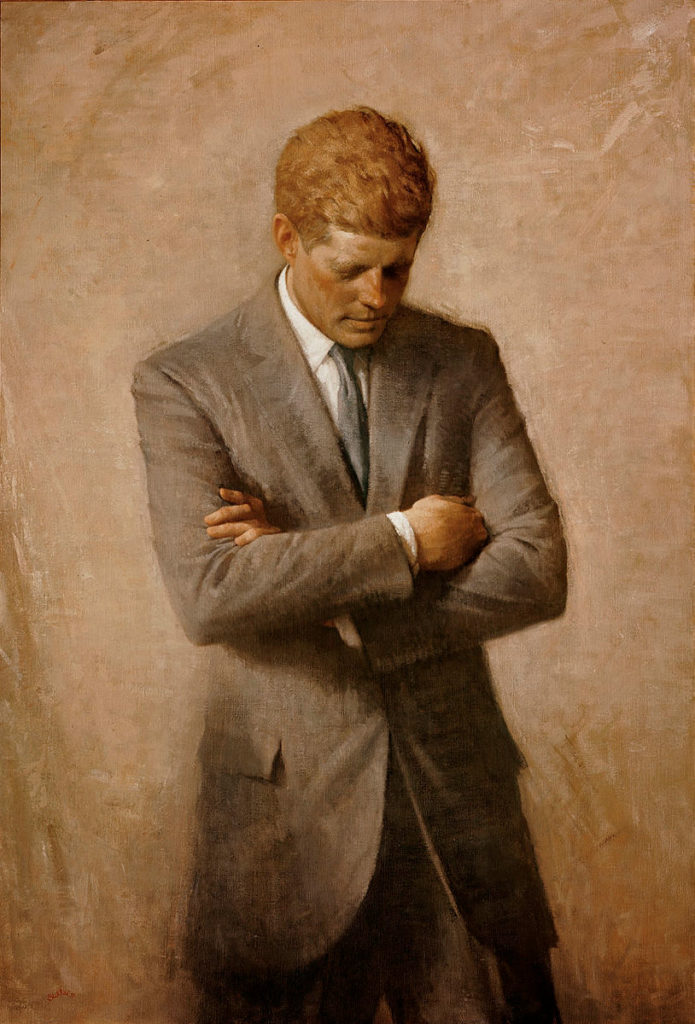
During Nixon’s re-election campaign in 1972, the press learned that the former First Lady’s second husband had made a sizable financial contribution to the campaign of the Republican president, while Mrs. Aristotle Onassis contributed to that of the Democratic candidate, her friend George McGovern and his running mate, Sargent Shriver, who was her brother-in-law, married to JFK’s sister Eunice.
Two years later, in March of 1973, Secretary of State Henry Kissinger was meeting with President Nixon in the Oval Office when the secret tape-recording system picked up a tidbit of the conversation that surprised the President. Kissinger was telling about a recent dinner he had attended in Mexico, at the estate of society figures Lowell and Gloria Guinesss. Among the other guests were Aristotle and Jacqueline Onassis.
To the Secretary of State, the former First Lady had high praise for the Republican President on his conducting foreign affairs. She said that Nixon visiting the Soviet Union and People’s Republic of China were bold and correct moves, ones which she revealed that President Kennedy had planned to take if he had lived to run for re-election and win a second term, but openly wondered if he would have even had the courage to do so because of attacks he would have gotten by rabidly anti-communist Republicans. Ironically, it was the sort of move that only a Republican could have taken.
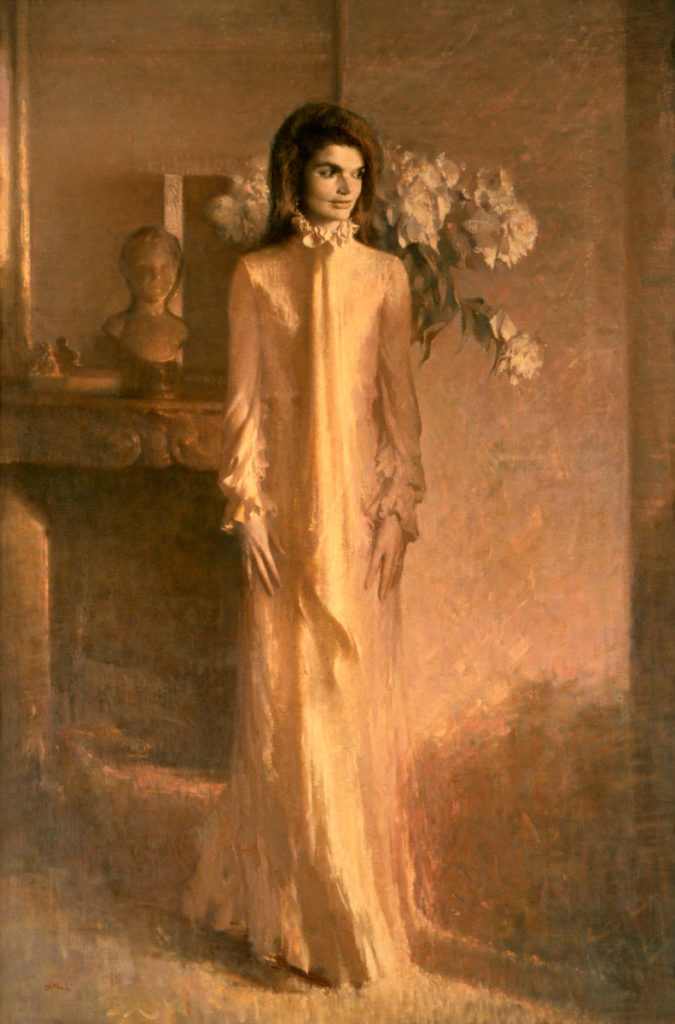
Jackie Onassis was in Italy in August of 1974 when Nixon resigned. When she made her annual September visit to her mother’s summer estate Hammersmith Farm in Newport, the two discussed the Nixon resignation. Jackie lamented that it was “all so Shakepearean. Here was one of the most brilliant statesmen of the twentieth century and yet he was his own worst enemy.”
In 1981, former President and Mrs. Nixon decided to leave their home in California and relocate once again to New York, residing on the upper East Side not far from Mrs. Onassis, now widowed a second time and working as a professional book editor. In a humor column in the New York Times, Russell Baker joked about Jackie and Nixon bumping into each other on a street corner and spilling the bagels in the bags they were carrying. In truth, they never did see each other despite their mutual proximity. At one point, while in her apartment, a phone call came through to her unlisted number. It was Richard Nixon calling to ask permission to quote her for one of his books.
By the 1980s, as the Nixon tapes were being released to the public, the former president’s mistrust of her brother-in-law, U.S. Senator Edward Kennedy and even the suggestion by an aide that they spy on him became widely known, the result of a fear that he might suddenly challenge Nixon in 1972. It was surely a factor that might have soured Jackie’s view of him.
Some have drawn the conclusion of antagonism because the Nixons were not invited to the 1979 dedication of the Kennedy Presidential Library. Yet former First Lady Bess Truman, who Jackie greatly admired, nor Mamie Eisenhower, or former President and Mrs. Ford were invited either. Lady Bird Johnson attended but she had been wife of Kennedy’s Vice President. Similarly, Jacqueline Onassis did not attend the 1991 dedication of the Nixon Presidential Library; yet neither did she attend those of LBJ, Ford, Carter, Reagan or Bush. At that point in her life, she identified less as a former First Lady and more as the mother of the late president’s two children, attending events at the JFK Library in support of her maturing children who by then were taking the helm of its foundation.
Then, as March of 1993 approached, Jacqueline Onassis learned that Pat Nixon was almost certain to be marking her last birthday. She wrote her a private letter to mark the occasion. It has never been publicly released. Pat Nixon died in June.

Less than a year later, both Jackie Kennedy Onassis and Richard Nixon would find themselves again sharing headlines, for poignant reasons. In April of 1994, the former First Lady and the former President were both admitted to New York Hospital, occupying private suites on separate floors, both sets of their children there to visit their ailing parent. Richard Nixon suffered a stroke and died in the hospital on April 22, 1994. Jacqueline Kennedy Onassis, suffering from non-Hodgkins lymphoma would survive to leave the hospital, but died at home several weeks later, on May 19, 1994.
Categories: First Daughters, First Families, First Ladies, First Sons, The Kennedys, The Nixons, Uncategorized
Tags: Jacqueline Kennedy Onassis, John F. Kennedy, John F. Kennedy Jr., Pat Nixon, Richard Nixon
 Jane & Jill, Potential First Ladies: Lots in Common Between the Wives of Joe Biden & Bernie Sanders
Jane & Jill, Potential First Ladies: Lots in Common Between the Wives of Joe Biden & Bernie Sanders  The President as King: A Political Cartoon History
The President as King: A Political Cartoon History  The First White House Valentine’s Day Dance: the McKinleys, Ragtime, Racism & The Romance of the “Ghost Girls”
The First White House Valentine’s Day Dance: the McKinleys, Ragtime, Racism & The Romance of the “Ghost Girls”  Liz Taylor Meets Jackie Kennedy: Tabloid Fantasy to Chance Encounter & The Only Photos of Them Together, Part I
Liz Taylor Meets Jackie Kennedy: Tabloid Fantasy to Chance Encounter & The Only Photos of Them Together, Part I  Liz Taylor Meets Jackie Kennedy: Tabloid Fantasy to Chance Encounter & The Only Photos of Them Together, Part II
Liz Taylor Meets Jackie Kennedy: Tabloid Fantasy to Chance Encounter & The Only Photos of Them Together, Part II  Melania Trump v. John Kelly: First Ladies & West Wing Personnel, A Brief History
Melania Trump v. John Kelly: First Ladies & West Wing Personnel, A Brief History
Leave a Reply